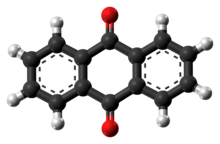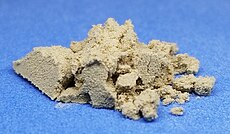Anthraquinone

| |

| |

| |
| Names | |
|---|---|
| Preferred IUPAC name
Anthracene-9,10-dione[2] | |
Other names
| |
| Identifiers | |
3D model (
JSmol ) |
|
| 390030 | |
| ChEBI | |
| ChEMBL | |
| ChemSpider | |
ECHA InfoCard
|
100.001.408 |
| 102870 | |
| KEGG | |
PubChem CID
|
|
RTECS number
|
|
| UNII | |
| UN number | 3143 |
CompTox Dashboard (EPA)
|
|
| |
| |
| Properties | |
| C14H8O2 | |
| Molar mass | 208.216 g·mol−1 |
| Appearance | Yellow solid |
| Density | 1.438 g/cm3[1] |
| Melting point | 284.8 °C (544.6 °F; 558.0 K)[1] |
| Boiling point | 377 °C (711 °F; 650 K)[1] |
| Insoluble | |
| Hazards | |
| Occupational safety and health (OHS/OSH): | |
Main hazards
|
possible carcinogen |
| GHS labelling: | |

| |
| Danger | |
| H350 | |
| P201, P202, P281, P308+P313, P405, P501 | |
| Flash point | 185 °C (365 °F; 458 K) |
| Related compounds | |
Related compounds
|
quinone, anthracene |
Except where otherwise noted, data are given for materials in their standard state (at 25 °C [77 °F], 100 kPa).
| |
Anthraquinone, also called anthracenedione or dioxoanthracene, is an
Synthesis
There are several current industrial methods to produce 9,10-anthraquinone:
- The oxidation of Chromium(VI)is the typical oxidant.
- The AlCl3. o-Benzoylbenzoic acid is an intermediate. This reaction is useful for producing substituted anthraquinones.
- The Diels-Alder reaction of naphthoquinone and butadienefollowed by oxidative dehydrogenation.
- The acid-catalyzed dimerization of styrene to give a 1,3-diphenylbutene, which then can be transformed to the anthraquinone.[3] This process was pioneered by BASF.
It also arises via the Rickert–Alder reaction, a retro-Diels–Alder reaction.
Reactions
Hydrogenation gives dihydroanthraquinone (anthrahydroquinone). Reduction with copper gives anthrone.[4] Sulfonation with sulfuric acid gives anthroquinone-1-sulfonic acid,[5] which reacts with sodium chlorate to give 1-chloroanthaquinone.[6]
Applications
Digester additive in papermaking
9,10-Anthraquinone is used as a digester additive in production of
Use in flow batteries
9,10-Anthraquinone is used as an electrolyte in flow battery which can provide long term electrical storage.
Niche uses
9,10-anthraquinone is used as a bird repellant on seeds, and as a gas generator in satellite balloons.[9] It has also been mixed with lanolin and used as a wool spray to protect sheep flocks against kea attacks in New Zealand.[10]
Other isomers
Several other isomers of anthraquinone are possible, including the 1,2-, 1,4-, and 2,6-anthraquinones. They are of comparatively minor importance. The term is also used in the more general sense of any compound that can be viewed as an anthraquinone with some hydrogen atoms replaced by other atoms or functional groups. These derivatives include substances that are technically useful or play important roles in living beings.
Recently, a class of anthraquinone derivates were shown to have self-healing properties when doped in PMMA matrix.[11]
Safety
Anthraquinone has no recorded LD50, probably because it is so insoluble in water.
In terms of metabolism of substituted anthraquinones, the enzyme encoded by the gene UGT1A8 has glucuronidase activity with many substrates including anthraquinones.[12]
See also
References
- ^ ISBN 9781498754293.
- ISBN 978-0-85404-182-4.
- ISBN 978-3527306732.
- .
- .
- .
- hdl:1853/24767.
- ISBN 0-89852-340-0.
- ^ "www.americanheritage.com". Archived from the original on 2009-06-09. Retrieved 2009-09-22.
- ^ Dudding, Adam (29 July 2012). "How to solve a problem like a kea". Sunday Star Times. New Zealand. Retrieved 11 November 2014.
- S2CID 5512565.
- PMID 1339448.
